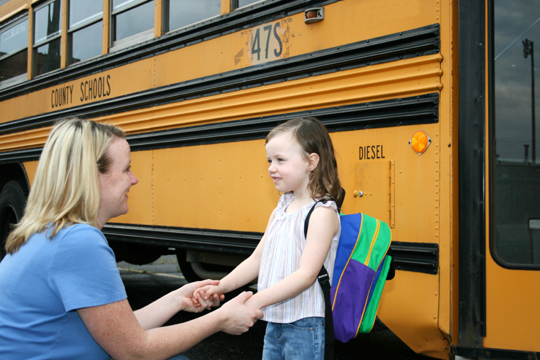First-Day Jitters: Helping Kids Adjust to a New School
Getting lost in the hallways, being surrounded by strangers, meeting a new teacher—adapting to a new environment is tough for anyone, but it’s particularly hard on children when they start a new school.
 And while it can lead to great friendships and learning opportunities down the road, in the short term a new school can also mean a great deal of fear and anxiety. Help quell your child’s first-day jitters with the tips below.
And while it can lead to great friendships and learning opportunities down the road, in the short term a new school can also mean a great deal of fear and anxiety. Help quell your child’s first-day jitters with the tips below.
Before the First Day
Consider your child’s age. While it’s as natural for teenagers as toddlers to be uneasy about a big change, the age of your child makes a difference in how they experience a new school. Young children are dealing with many firsts at the same time and starting school is just one more thing they have to adjust to. Make life a little easier by avoiding the introduction of other big changes at the same time, such as a new extracurricular activity, and giving them plenty of notice before you initiate a change. Older children and teenagers, on the other hand, are just beginning to establish their own identity and can find it hard to handle a different social situation.
Listen. Be sure to recognize your kids’ fears and expectations, and remind them that it will take time to adjust. Regardless of your children’s age, your patience and understanding will help alleviate these growing pains.
Test out the school. Children are often frightened by what they don’t know, so why not eliminate that element of the unknown by taking a tour of the school before classes start? If possible, arrange for children to sit in on classes for a day or set up a meeting between your child and the new teacher. You could even ask your child’s teacher if they have a buddy program, where your child is assigned to a partner from their class to get a little support and one-on-one guidance throughout the first few days. Once children get a sense of what to expect, they’ll probably be less anxious about the move.
Encourage introductions. Teach younger kids how to introduce themselves. Show children how to approach and greet other students, and practice by role-playing different scenarios.
After the First Day
Keep an eye online. Children now have a whole range of methods, from e-mail to online chatting, to keep in touch with old friends. But while contacting former classmates can help relieve anxiety, it can also keep children from making friends in their new environment.
Encourage personal connections. The more children are involved in school activities, the more they’ll enjoy their time at school. If your child has mentioned friendships with other students, arrange get-togethers or play dates so they can spend time together outside of class. Encourage older children to get involved in after-school activities like sports or drama. Not only will they begin to feel more comfortable in their new environment, but they’ll also have the chance to develop a new network of friends.
Explore life outside school. Because a change in schools has such a huge impact on a child’s life, it’s important to provide a comfortable environment at home. Consider getting involved with programs or activities in the community that you can do together as a family. The effort and time with family can enhance children’s sense of security.
Be patient. Even after preparing kids for the change, they might still have some anxiety and even a certain amount of resentment toward you for the first month. This is a perfectly natural reaction: Realize that it will take time before your child feels totally comfortable.
Remain positive. Children need time to absorb and accept changes. Remind them, and yourself, that change is an opportunity for new and exciting things in the future. Children are especially sensitive to your ambivalence and anxiety around change, so it’s important that you talk to them about the positive aspects of the change.
Watch for warning signs. Almost every child will have some difficulty adjusting, but it’s important to watch for signals that a child is seriously struggling. These include discipline problems, a noticeable drop in grades, physical health problems and negative behavior such as withdrawal or anger that last longer than one month. If you spot any of these signs, consider seeking additional support for your child.
Change can be nerve-wracking for everyone, but it’s particularly hard on kids, who are still in the process of learning who they are and how they fit in to their social circle. Keep in mind that with a little preparation and a lot of support, you can help your child pass this challenging time of transition with flying colors.
